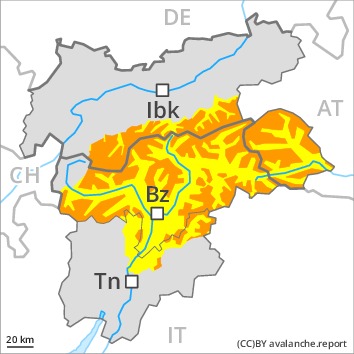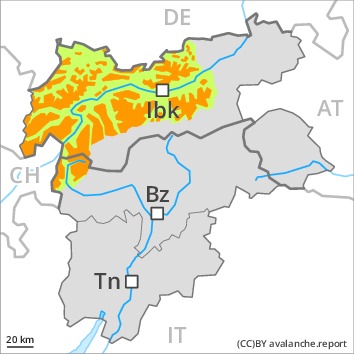
Danger level
 | treeline
|
Avalanche Problem
 | | Wind-drifted snow |
|  | |  |
 | | Wind-drifted snow |
|  | |  |

Fresh and older wind slabs require caution.
On wind-loaded slopes a critical avalanche situation will be encountered over a wide area. The fresh and somewhat older wind slabs can be released easily in all aspects. Caution is to be exercised in particular adjacent to ridgelines and in gullies and bowls. Mostly the avalanches are medium-sized. The prevalence of avalanche prone locations and likelihood of triggering will increase with altitude. Caution and restraint are required.
Snowpack
dp.6: cold, loose snow and wind
As a consequence of a strong wind from southwesterly directions, avalanche prone wind slabs will form in all aspects. In many cases wind slabs are lying on soft layers. In some cases new snow and wind slabs are lying on surface hoar, in particular in areas close to the tree line. Stability tests and field observations confirm this situation. These avalanche prone locations are sometimes covered with new snow and are barely recognisable, even to the trained eye. The old snowpack is largely stable. 2 to 10 cm of snow, and up to 15 cm in some localities, will fall on Friday.
Tendency
Fresh wind slabs are to be evaluated with care and prudence. Increase in avalanche danger as a consequence of new snow and wind.

Danger level
 | treeline
|
Avalanche Problem
 | | Wind-drifted snow |
|  | |  |
 | | Persistent weak layer |
|  | |  |

Wind slabs are to be evaluated critically.
Fresh wind slabs represent the main danger. The fresh and somewhat older wind slabs can be released easily, even by a single winter sport participant, especially on steep shady slopes above the tree line, caution is to be exercised in particular adjacent to ridgelines and in gullies and bowls. Mostly the avalanches are medium-sized. The number and size of avalanche prone locations will increase with altitude.
Weak layers in the lower part of the snowpack can still be released in isolated cases by individual winter sport participants. Caution is to be exercised in particular on steep shady slopes above approximately 2200 m, especially in areas where the snow cover is rather shallow, as well as at transitions from a shallow to a deep snowpack, when entering gullies and bowls for example.
Snowpack
dp.6: cold, loose snow and wind
dp.1: deep persistent weak layer
In many cases wind slabs are lying on soft layers, also below the tree line. The wind slabs are lying on surface hoar in some places at intermediate and high altitudes. Snow profiles confirm this situation.
Steep shady slopes: The old snowpack will be prone to triggering in some places. Towards its base, the snowpack is faceted and weak. Whumpfing sounds and the formation of shooting cracks when stepping on the snowpack are a clear indication of a weakly bonded snowpack.
Some snow will fall in some localities, in particular in the south.
Tendency
Fresh wind slabs are to be evaluated with care and prudence.

Danger level
 | treeline
|
Avalanche Problem

Wind slabs are to be evaluated with care and prudence.
The fresh and somewhat older wind slabs are in some cases prone to triggering above the tree line, especially adjacent to ridgelines and in gullies and bowls. Mostly avalanches are only small but can be released also by a single winter sport participant. The prevalence of avalanche prone locations and likelihood of triggering will increase with altitude.
Snowpack
dp.6: cold, loose snow and wind
As a consequence of new snow and a strong wind from southerly directions, mostly small wind slabs formed above the tree line. In some places wind slabs are lying on soft layers, especially on shady slopes.
Tendency
The avalanche danger will persist.













